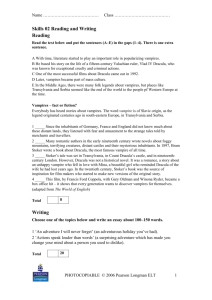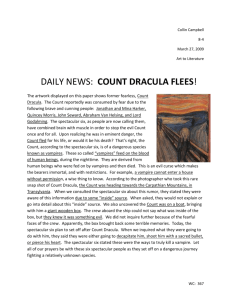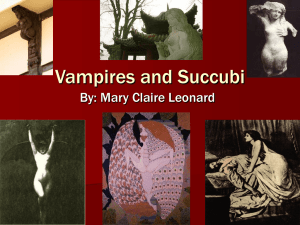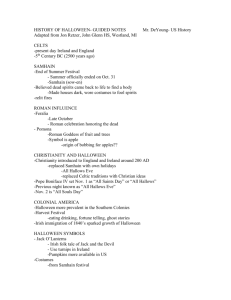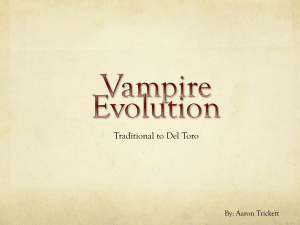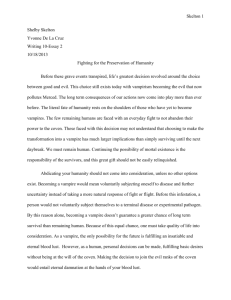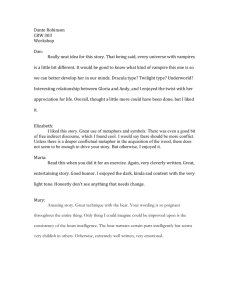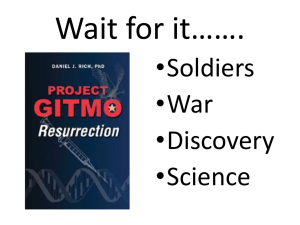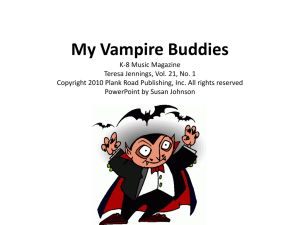Vampires FSLT proposal - Office of the Provost
advertisement
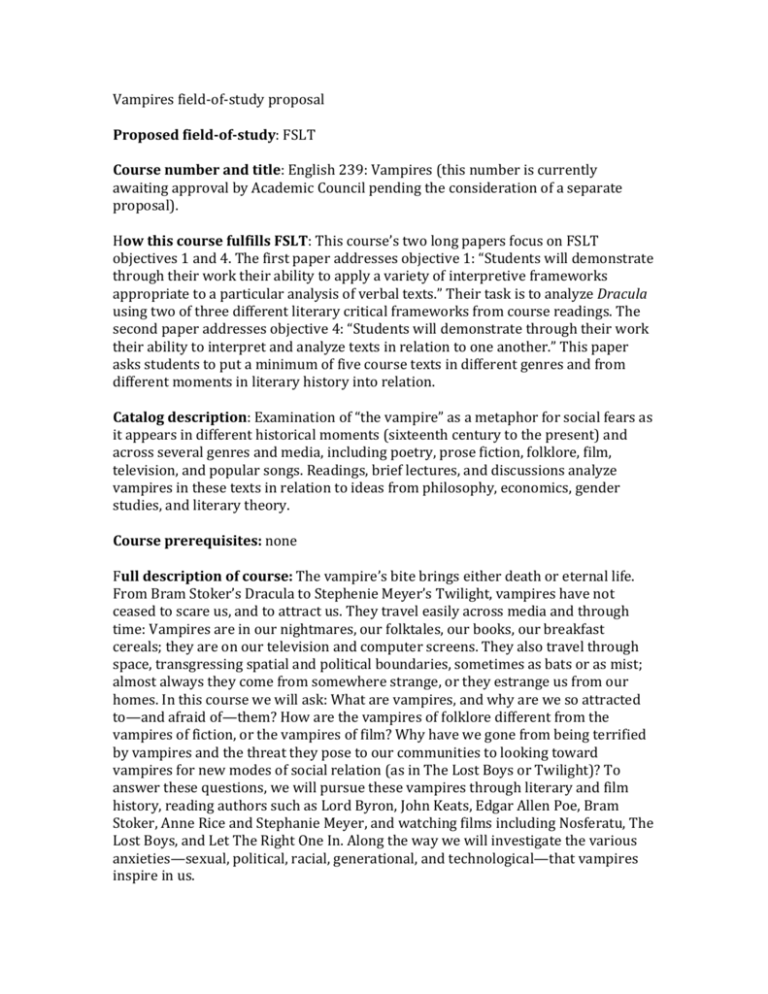
Vampires field-­‐of-­‐study proposal Proposed field-­‐of-­‐study: FSLT Course number and title: English 239: Vampires (this number is currently awaiting approval by Academic Council pending the consideration of a separate proposal). How this course fulfills FSLT: This course’s two long papers focus on FSLT objectives 1 and 4. The first paper addresses objective 1: “Students will demonstrate through their work their ability to apply a variety of interpretive frameworks appropriate to a particular analysis of verbal texts.” Their task is to analyze Dracula using two of three different literary critical frameworks from course readings. The second paper addresses objective 4: “Students will demonstrate through their work their ability to interpret and analyze texts in relation to one another.” This paper asks students to put a minimum of five course texts in different genres and from different moments in literary history into relation. Catalog description: Examination of “the vampire” as a metaphor for social fears as it appears in different historical moments (sixteenth century to the present) and across several genres and media, including poetry, prose fiction, folklore, film, television, and popular songs. Readings, brief lectures, and discussions analyze vampires in these texts in relation to ideas from philosophy, economics, gender studies, and literary theory. Course prerequisites: none Full description of course: The vampire’s bite brings either death or eternal life. From Bram Stoker’s Dracula to Stephenie Meyer’s Twilight, vampires have not ceased to scare us, and to attract us. They travel easily across media and through time: Vampires are in our nightmares, our folktales, our books, our breakfast cereals; they are on our television and computer screens. They also travel through space, transgressing spatial and political boundaries, sometimes as bats or as mist; almost always they come from somewhere strange, or they estrange us from our homes. In this course we will ask: What are vampires, and why are we so attracted to—and afraid of—them? How are the vampires of folklore different from the vampires of fiction, or the vampires of film? Why have we gone from being terrified by vampires and the threat they pose to our communities to looking toward vampires for new modes of social relation (as in The Lost Boys or Twilight)? To answer these questions, we will pursue these vampires through literary and film history, reading authors such as Lord Byron, John Keats, Edgar Allen Poe, Bram Stoker, Anne Rice and Stephanie Meyer, and watching films including Nosferatu, The Lost Boys, and Let The Right One In. Along the way we will investigate the various anxieties—sexual, political, racial, generational, and technological—that vampires inspire in us. Proposed syllabus: attached as separate document (from previously offering this course as ENG299: Special Topics in Literary Analysis). Reading list: • Novels: Paul Barber, Vampires, Burial, and Death; Bram Stoker, Dracula; Anne Rice, Interview with the Vampire. • Short stories: Elizabeth Mary Braddon, “The Good Lady Ducayne”; John Polidori, “The Vampyre”; Alfred, Lord Byron, “Fragment of a Novel”; J. Sheridan Le Fanu, “Carmilla”; Guy de Maupassant, “Le Horla.” • Poems: Johann Wolfgang von Goethe, “The Bride of Corinth”; John Keats, “Lamia” and “La belle dame sans merci”; Samuel Taylor Coleridge, “Christabel”; Charles Baudelaire, “The Vampire” and “Metamorphoses of the Vampire” • Critical essays: Ken Gelder, “Reading Dracula” and “Vampires and Cinema”: Nina Auerbach, “Dracula: A Vampire of Our Own”; Franco Moretti, “The Dialectic of Fear” • Motion Pictures: Nosferatu, The Lost Boys, Bram Stoker’s ‘Dracula,’ Buffy the Vampire Slayer, Twilight, Let the Right One In Statement of Course Objectives. Since this course was first designed and taught as ENG299, which is an FSLT course, FSLT objectives 1 and 4 are its primary objectives. This course, unlike a number of the other 200-­‐level FSLT courses offered in English, focuses on several genes and media (folklore, poetry, short stories, novels, films, television shows, popular music) and its texts come from a span of literary history stretching from early modernity through the present. Full details on how the course will be taught. Class time is 75% discussion and 25% lecture (mainly to explain and demonstrate the terminology and methodology of literary and motion picture analysis). In both cases, our attention is always on the texts students have read or watched for class. Number of units: One. Typical estimate of enrollment: 20. One or two sections of this course have been offered as ENG299 four previous fall semesters and the sections have always reached capacity. How often and by whom will the course be offered: Nathan Snaza will teach the course every year, as needed. Staffing Implications: None. Nathan Snaza has been teaching the course as English 299, “Special Topics in Literary Analysis”; we simply want to make the course a permanent part of the departmental curriculum. Adequacy of library, technology, and other resources: No new materials or resources are needed. Any interdepartmental or interschool implications: This course is cross-­‐listed with Women, Gender, and Sexuality Studies. SYLLABUS Dr. Nathan Snaza English 299: Vampires, Section 1 322 Ryland Hall University of Richmond Office Hours: MW 11 AM – 12:00 PM Fall 2013 (and by appointment) Monday and Wednesday 9:00 – 10:15 (804) 289-8300 Room: Ryland 205 nsnaza@richmond.edu Since Bram Stoker’s Count Dracula landed in Victorian England, the vampire has been a threat to the social body and, in particular, to the social institutions of the family. The threat of the vampire is, first of all, its excessive sexuality. Its desire for flesh is insatiable, and its erotic bite strikes men and women equally, undermining the order of heterosexual coupling. Second, the vampire undermines the reproductive order of the family with its own, alternative mechanism of reproduction. New vampires are created by the bite of both male and female vampires, forming an eternal race of the undead. The vampire thus functions in the social imagination as one figure of the monstrosity of a society in which the traditional social bodies, such as the family, are breaking down. It should come as no surprise, then, that vampires have become so prevalent in recent years in popular novels, films, and television. Our contemporary vampires turn out to be different. The vampires are still social outsiders, but their monstrosity helps others to recognize that we are all monsters—high school outcasts, sexual deviants, freaks, survivors of pathological families, and so forth. And more important, the monsters begin to form new, alternative networks of affection and social organization. The vampire, its monstrous life, and its insatiable desire has become symptomatic not only of the dissolution of an old society but also the formation of a new. -Michael Hardt and Antonio Negri, Multitude (2004) COURSE DESCRIPTION The vampire’s bite brings either death or eternal life. From Bram Stoker’s Dracula to Stephenie Meyer’s Twilight, vampires have not ceased to scare us, and to attract us. They travel easily across media and through time: Vampires are in our nightmares, our folktales, our books, our breakfast cereals; they are on our television and computer screens. They also travel through space, transgressing spatial and political boundaries, sometimes as bats or as mist; almost always they come from somewhere strange, or they estrange us from our homes. In this course we will ask: What are vampires, and why are we so attracted to—and afraid of—them? How are the vampires of folklore different from the vampires of fiction, or the vampires of film? Why have we gone from being terrified by vampires and the threat they pose to our communities to looking toward vampires for new modes of social relation (as in The Lost Boys or Twilight)? To answer these questions, we will pursue these vampires through literary and film history, reading authors such as Lord Byron, John Keats, Bram Stoker, and Anne Rice, and watching films including Nosferatu, The Lost Boys, Twilight, and Let The Right One In. Along the way we will investigate the various anxieties—sexual, political, racial, generational, and technological—that vampires inspire in us. COURSE TEXTS Barber, Vampires, Burial, and Death (2nd Ed 2010) Rice, Interview with the Vampire (1976) Ryan, The Penguin Book of Vampire Stories (1987) Stoker, Dracula (1897) All other readings will be posted on the course Blackboard site (as either PDF documents or external internet links). PRINT these readings and bring them to class. We will also be watching six films and one episode of a television show during the course. With one exception, you are expected to view them outside of class before the date listed on the syllabus for discussion. All films will be available in the Media Resource Center on the second floor of Boatwright Library; four will also be broadcast on the campus television network (schedule forthcoming). You may also be able to find the films to rent at local businesses or through Netflix. ASSIGNMENTS (detailed assignment instructions will be given as separate handouts) You will write two papers for the course. The first (4-5 pages), due on October 11, will ask you to examine the function of either gender or technology in Dracula while drawing on critical interpretations of the novel. For the second (5-7 pages), due on December 6, you will be given several topics from which to choose, and each will ask you to put a minimum of two course texts into conversation. There are two exams in this course: a mid-term examination on October 30, and a final examination, which will be given during the university-assigned exam period for your section. Class Discussions and Lectures You are expected to come to class having CAREFULLY read the assigned reading. This means having read the ENTIRE text and taken notes on the reading (this may be as simple as underlining or flagging with post-it notes passages that strike you or that you have questions about). You are expected to ground your comments about the texts in specific references to page numbers (or temporal bounds in the case of film). Your comments in class should demonstrate your thoughtful engagement with both the readings and our discussions. That is, you are expected to actively contribute to the discussion in class by offering interpretations and asking questions, both of me and of your fellow classmates. GRADES Paper One: 25% Mid-term Exam: 15% Paper Two: 40% Final Examintion: 20% NOTE: All other course readings will be posted on the course blackboard site as PDFs. You should print these readings and bring them to class with you when we discuss them. COURSE POLICIES Attendance: Attendance is mandatory and will be recorded. You are allowed a total of three absences during the semester. For each additional absence, your final grade will be penalized one step (e.g., five absences makes an A- a B). If you are late by five minutes or more, this will be counted as an absence. Computer and Phone Policy: The use of cellular phones, laptop computers, and other digital communications devices is not allowed at any time in class. Cellular phones must be turned off during class. All notes must be taken by hand. Late Work Policy: Late CREs will not be accepted. Late papers will be penalized one step per day late (not per class day late). All work must be turned in hard copy during class. No emailed work will be accepted. ON-CAMPUS SERVICES Academic Skills Center (http://asc.richmond.edu or 289-8626) helps students assess their academic strengths and weaknesses; hone their academic skills through teaching effective test preparation, critical reading and thinking, information processing, concentration, and related techniques; work on specific subject areas (e.g., calculus, chemistry, accounting, etc.); and encourage campus and community involvement. Career Development Center (http://cdc.richmond.edu/ or 289-8141) can assist you in exploring your interests and abilities, choosing a major, connecting with internships and learning experiences, investigating graduate and professional school options, and landing your first job. We encourage you to schedule an appointment with a career advisor during your first year. Counseling and Psychological Services (289-8119) assists students in meeting academic, personal, or emotional challenges. Services include assessment, short-term counseling and psychotherapy, crisis intervention and related services. Speech Center (http://speech.richmond.edu or 289-8814): Assists with preparation and practice in the pursuit of excellence in public expression. Recording, playback, coaching and critique sessions offered by teams of student consultants trained to assist in developing ideas, arranging key points for more effective organization, improving style and delivery, and handling multimedia aids for individual and group presentations. Writing Center assists writers at all levels of experience, across all majors. Students can schedule appointments with trained writing consultants who offer friendly critiques of written work: http://writing.richmond.edu SOME HELPFUL RESOURCES I take it for granted that literature, more than anything else, is “about” language: the words, the syntax (word order), rhetorical language, meter (for poetry). Therefore, the following resources will be of use to you. Oxford English Dictionary (OED). This is the dictionary to use – it includes comprehensive lists of meanings, as well as very useful etymological information. You have access to it online, for free, through the University Library website or at http://dictionary.oed.com/entrance.dtl A glossary of rhetorical terms. This list is comprehensive and many of the listed forms pertain only to ancient languages, but it’s a good place to go if you’re not sure what, for example, asyndeton is. http://www.uky.edu/AS/Classics/rhetoric.html A Glossary of poetic terms from the American Academy of Poets. http://www.poets.org/viewmedia.php/prmMID/17105 You may wish to consult one or more of the following vampire biblio- and filmographies: o http://vampirefilmography.blogspot.com/ o http://www.wsu.edu/~delahoyd/vampirefilms.html o http://www.afn.org/~vampires/bkslist.html o http://www-lib.usc.edu/~melindah/eurovamp/vampeuro.html SOME GENERAL GUIDELINES CONCERNING WRITING AND INTERPRETATION FOR ENG299; Or, The Fine Print Writing a paper for college – just like any act of reading — is a process, not a magic trick. I don’t assume, let alone expect, that you can produce a consistent argument in error-free prose in one night, in one week, or in one month. Writing a good paper, any paper, takes a lot of time, thought, and revision. With this general lesson in mind, I offer the following pieces of advice. • • • • • Your paper must consist of a single, sustained, coherent argument about a literary text from the course. Every single sentence in your paper needs to do something relative to your main argument. This main argument must be given, in some way, at the start of the paper. This is traditionally called your “thesis.” Note: the thesis need not be a single sentence. Your paper should be an exercise in “close reading.” This means that your thesis should concern the meaning of a very small piece of language, a meaning you explain in explicit detail (the traditional term is “explicate”). A rule of thumb: if you find yourself citing more than one sentence at a time, you’re probably not close reading. Think of it this way: your argument will always have the form of: “this” [a piece of text, a collection of “signifiers”] means “this” [a possibly coherent, possibly nonsensical set of ideas, affects, effects, etc.; a “signified” in the parlance of linguistics]. The real task (or trial; literally: “essay”) is showing, exhaustively as you can, what “means” means in the specific situation you are writing about. Your paper must have an introduction and a conclusion. The introduction should lay the ground for your argument: what is the domain you’ll be covering? A good introduction lets the reader know what kinds of questions you’ll be putting to a text, as well as what discourses you’ll be referring to in your argument. After reading a good introduction I should never find myself surprised by the appearance of a topic in the paper (even if I might be surprised by your interpretation of the topic). Thus, the best introductions are written after the rest of the paper, because: Writing is exploration. Most of us, maybe all of us, don’t know what we think exactly until we’ve written it. You should learn what you think through the act of writing. Thus, I don’t expect you to know the ins-and-outs of your argument until you’ve made it. When you’re done, you need to go back over the whole thing, tightening the argument, cutting extraneous sections, adding detail or emphasis where necessary. Everything depends on how well you construct your argument; therefore, I cannot provide grading rubrics for these papers. Each argument makes demands, and my job is to assess the extent to which your text meets those demands. There are no such things as absolutely “right” or “wrong,” for the most part, in literary analysis. There are no “methods” that guarantee validity, as there are for most sciences. The humanities have a • • • • • • • very different set of assumptions about ontology, epistemology, and methodology. Suffice it to say that what we rely on, above everything else, is strong argumentation. I will accept no claim you make that is not supported and argued for (put differently, it’s not enough to make claims I agree with: this class has nothing to do with which readings I prefer). I need to see exactly how you get from ink on a page to a full “reading” (in the strong sense, see “Useful Quotation” by J. Hillis Miller below). You may wish to write with your high school mathematics teacher’s voice in mind: show your work! When the passage you are writing about contains a figure (that is, a piece of figural language), I expect you to work it out in detail. When you come across these figures, you need to analyze exactly how the comparison works (in the case of metaphor, metonymy and simile) or how the figure cognizes its object (in the case of synecdoche, prosopopoeia, apostrophe, irony). You should be able to argue not only how the figure functions, but also why it is used where it is used. Many passages will contain grammatical or syntactical oddities and/or intricacies you will need to explain in the course of a good interpretation. When this is the case, please make sure you are correctly describing the grammar (you can ask for help on this). While I don’t necessarily want you to comment on every word, I expect that your interpretation can account for every word. Put differently, if your interpretation has to ignore some part of the passage, it makes your reading invalid. Do not generalize. You can make claims about the text you’re discussing and that text alone. References to “all time,” “throughout history,” or even the historical period under discussion (in this last case, unless very well supported) are not acceptable. (Yes, “do not generalize” is too general a motto, but it seems necessary as a corrective to the most insidious affliction facing undergraduate writers: hyperbolic generalization.) The goal of interpretation is not paraphrase. Paraphrase is not interpretation. The goal of interpretation is not plot summary. Plot summary is not interpretation. That said, you need, at all times, to keep in mind where your passage occurs in the text. You need to think about what has already happened that might be influencing the speech or narration, as well as what the characters (including narrators) know at this point. Finally, I want to note that an exciting, original, ambitious reading will be more highly rewarded than an obvious or common one (by which I mean: you have to think something interesting to get an A or a B in this class). I would rather see you try for something very difficult and demanding and not quite pull it off, than to masterfully articulate something banal. This class is, ultimately, about learning to think and I will do what I can to reward serious thought. …AND GENERAL FORMATTING GUIDELINES: • Please follow the MLA style manual for all of your citation. For in-text citation, you simply give the author’s last name followed by a comma and the page number the quote appears on. You do not need to make Works Cited pages for your papers, unless you cite texts from outside the course’s reading list. This should only be done after conferring with me. • When you cite a dictionary in your writing for this class, only use the Oxford English Dictionary. No other dictionary is appropriate for this class. Don’t cite Dictionary.com or Wikipedia.org, ever. • Please number your pages. This function, in Microsoft Word, is called “Page Numbers” and is part of the drop-down menu, “Insert.” Please put them in the bottom right-hand corner. • • • • • • • Do not provide title pages. In the upper left hand corner of your paper you should print: your name, the course information (e.g., “ENG299, Section 1, Fall 2013”), and the assignment name (e.g., Paper 1), each on a separate line, single-spaced. For a page of your text to count toward the page requirement of the assignment, it must be at least 2/3 covered with your typed prose. A Works Cited page does not count toward the total, nor is it necessary if you are only citing course texts. If you wish to include images in your paper, be aware that they do not count toward the page requirement. For this reason, you may wish to include all images as appendices using a standardized system of notation (I.e., “see Image 1”). Use 1” margins on the top and bottom of your word processing document, 1.25” margins on the sides. You must type your papers in Times New Roman 12 point font—NO EXCEPTIONS! You should get in the habit of titling your papers. The title should be one full space below the student info, and one full space above the first paragraph of your paper. Titles should let the reader know two things, at a minimum: the text about which you will be writing, and the central problem about which you will make an argument. When you cite exact words from the text, you always need to use quotation marks. Always. Even if you give your passage as a block quote at some point, every time you cite a word from it, use quotation marks. You do not, however, need to include parenthetical citations in analysis after you have already given the page number. For quotations longer than four lines in Microsoft Word, you must “block” cite them. You begin the passage on a new line, without quotation marks, except internal ones and you indent the entire passage one tab from the left. The citation information is given after final punctuation, in parentheses. … and three final pieces of advice: • Proofread your paper. When you think you’re finished, print the paper (it’s always best to proofread on paper, not on screen, so you can make notes with a pen about what needs modification), make yourself some coffee or tea, and go over the paper slowly. Read the paper out loud – this will help you catch awkward phrases (because they will sound wrong when spoken). • Make an appointment with the Writing Center to have a trained staff person help you with your paper. • Come talk to me about your paper during my office hours. Show me drafts of paragraphs. Ask for help. SOME HELPFUL QUOTATIONS (a short dictionary of terms important to this class) “HISTORY” “[H]istory is not a text, not a narrative, master or otherwise, but… as an absent cause, it is inaccessible to us except in textual form,… our approach to it and to the Real itself necessarily passes through its prior textualization.” -Fredric Jameson, The Political Unconscious (1980) “THE INTENTIONAL FALLACY” “[T]he design or intention of the author is neither available nor desirable as a standard for judging the success of a work of literary art.” W.K. Wimsatt, Jr. & Monroe C. Beardsley, “The Intentional Fallacy” (1946) “METAPHOR” “In understanding imaginative metaphor we are often required to consider not how B (vehicle) explains A (tenor), but what meanings are generated when A and B are confronted or seen each in light of the other… a copresence of likeness and difference is necessary for the indefinite radiations of meaning, the solidity and concreteness, for which metaphor is prized.” -W.K. Wimsatt, Jr., The Verbal Icon (1953) “OBJECTIVITY” “We shall always tend to consider people’s distress objectively—that is, to place ourselves, with our own wants and sensibilities, in their conditions, and then to examine what occasions we should find in them for experiencing happiness or unhappiness. This method of looking at things, which seems objective because it ignores the variations in subjective sensibility, is, of course, the most subjective possible, since it puts one’s own mental states in the place of any others, unknown though they may be.” -Sigmund Freud, Civilization and Its Discontents (1930) “ READER AS PLACE” A “text is made of multiple writings, drawn from many cultures and entering into mutual relations of dialogue, parody, contestation, but there is one place where this multiplicity is focused and that place is the reader, not, as was hitherto said, the author. The reader is the space on which all the quotations that make up a writing are inscribed without any of them being lost; a text’s unity lies not in its origin but in its destination.” -Roland Barthes, “The Death of the Author” (1968) “READING” “What happens when I read, when I really read, which does not happen all that often? What happens is something always fortuitous and unpredictable, something surprising, however many times the book in question has been read before, even by me. One way to define this unexpected quality of true acts of reading is to say that they never correspond exactly to what other readers tell me I am going to find when I read that book, however learned, expert, and authoritative those previous readers have been. Another way to describe what is unpredictable about a genuine act of reading is to say that reading is always the disconfirmation or modification of presupposed literary theory rather than its confirmation. What happens when I read a particular book never quite fits my theory (or anyone else’s) of what is going to happen. You can never be sure what is going to happen when someone in a particular situation reads a particular book. Rather than thinking of all those books on the shelf as the sure and safe repository of the values of Western culture, the army of unalterable law ranged in rows, it might be better to think of them as so many unexploded bombs that may have who knows what result when they get read by the right (or the wrong) person at the right (or the wrong) place or time. A book is a dangerous object, and perhaps all books should have warning labels. Strange things happen when someone reads a book. “ -J. Hillis Miller, Versions of Pygmalion (1990) “In effect, it is impossible to interpret a work, literary or otherwise, for and in itself, without leaving it for a moment, without projecting it elsewhere than upon itself. Or rather, the task is possible, but then description is merely a word-for-word repetition of the work itself. It espouses the forms of the work so closely that the two are identical. And, in a certain sense, every work constitutes its own best description. “What comes closest to this ideal but invisible description is, simply, a reading, insofar as a reading is no more than a manifestation of the work. Yet the process of reading is already not without consequences: two readings of a book are never identical. In reading, we trace a passive writing; we add and suppress, in the text read, what we want or do not want to find there; reading is no longer immanent, once there is a reader.” -Tzvetan Todorov, Introduction to Poetics (1968) “THE SCHOLAR” “The determining impingement on most knowledge produced in the contemporary West (and here I speak mainly about the United States) is that it be nonpolitical, that is, scholarly, academic, impartial, above partisan or small-minded doctrinal belief. One can have no quarrel with such an ambition in theory, perhaps, but in practice the reality is much more problematic. No one has ever devised a method for detaching the scholar from the circumstances of life, from the fact of his involvement (conscious or unconscious) with a class, a set of beliefs, a social position, or from the mere activity of being a member of society.” -Edward Said, Orientalism (1978) “THE SIGN” “The linguistic sign unites, not a thing and a name, but a concept and a sound-image. The latter is not the material sound, a purely physical thing, but the psychological imprint of the sound, the impression that it makes on our senses… “I call the combination of a concept and a sound-image a sign… “I propose to retain the word sign to designate the whole, and to replace concept and soundimage respectively by signified and signifier… “The bond between the signifier and signified is arbitrary.” -Ferdinand de Saussure, Course in General Linguistics (1906-11) “TRUTH” “What then is truth? A moveable host of metaphors, metonymies, and anthropomorphisms: in short, a sum of human relations which have been poetically and rhetorically intensified, transferred, and embellished, and which, after long usage, seem to a people to be fixed, canonical, and binding.” -Friedrich Nietzsche, “On Truth and Lies in an Extramoral Sense” (1873) “WORDS” “Our speech, that is, all our utterances (including creative works), is filled with others’ words, varying degrees of otherness or varying degrees of ‘our-own-ness,’ varying degrees of awareness and detachment. These words of others carry with them their own expression, their own evaluative tone, which we assimilate, rework, and re-accentuate.” -Mikhail Bakhtin, “The Problem of Speech Genres” (1975) COURSE SCHEDULE 8-26: Syllabus and introductions; Twilight (2008) 8-28: Twilight UNIT ONE The Vampire as Problematic: Ontology, Epistemology, Methodology; Gender and Sexuality; Capitalism 9-2: Stoker, Dracula I-XIII 9-4: Stoker, IX-XV 9-19: Stoker, XVI-XXII 9-11: Stoker, XXIII-Note (end of the novel) 9-16: Marx, excerpts from Capital; Moretti, “The Dialectic of Fear” (BB) 9-18: Gelder, “Reading Dracula” from Reading the Vampire (BB) 9-23: 10 to noon: special presentation by Dr. Michelle Peace, professor of forensic science at Virginia Commonwealth University on body decomposition in JEPSON 120. Barber, from Vampires, Burial, and Death, 1-65. 9-25: Barber, from Vampires, Burial, and Death, 66-132; 195-197. 9-30: Auerbach, “Dracula: A Vampire of Our Own” from Our Vampires, Ourselves (BB) UNIT 2 Gendered Duty and the Powers of (Sexual?) Attraction 10-2: Goethe, “The Bride of Corinth” (1797; BB) 10-7: Coleridge, “Christabel” (1801); Keats, “Lamia” and “La belle dame sans merci” (1819); Baudelaire, “The Vampire,” “Metamorphoses of the Vampire” (1868) (BB) 10-9: Braddon, “Good Lady Ducayne” (1896, PBVS) Paper One Due Fall Break 10-21: Le Fanu, Carmilla (1872, PBVS) UNIT 3: Dracula Comes To (and From) The Movies 10-23: Analyzing Film: Terminology and Strategies 10-28: Nosferatu (1922) 10-30: In-Class Examination (Cumulative To Date) 11-4: Bram Stoker’s Dracula (1992) and Gelder, “Vampires and Cinema: From Nosferatu to Bram Stoker’s ‘Dracula’” from Reading The Vampire 11-6: Buffy The Vampire Slayer, Season 5 Episode 1: “Buffy Vs. Dracula” (2000; on reserve, on Netflix) *Also on reserve at the MRC are Dracula (1931) and Dracula (1958); these are recommened viewing, but will not be covered on the exams UNIT 4: The Vampire As Friend 11-11: Byron, “Fragment” (1816, PBVS); Polidori, “The Vampyre” (1819, PBVS) 11-13: The Lost Boys (1987) 11-18: Rice, Interview with the Vampire (3-94) 11-20: Rice, cont. (95-198) 11-25: Rice, cont. (201-340) 12-2: Let The Right One In (2008) CONCLUSION: “The Reign of Man Is Over” 12-4: Maupassant, “Le Horla” (1887, BB) Paper Two Due FINAL EXAMINATION:
